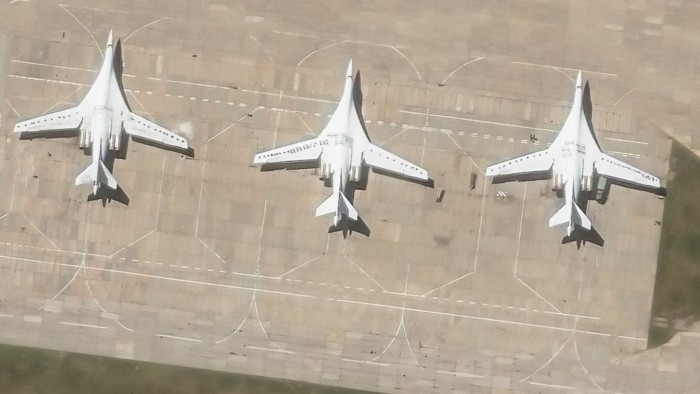Bombers that Russia may never rebuild. A fleet so mauled it may force Moscow to rethink how it raids Ukraine. Deep strikes on Russian soil that expose the price of a long war — even against a weaker foe.
As the toll of Ukraine’s weekend drone raid becomes clear from satellite imagery and expert assessments, so does the scale of the operation.
Ukraine’s audacity — plotting for 18 months to hide drones in trucks to hit military airfields thousands of kilometres from Kyiv — has largely been matched by the material damage done to Russia’s bomber force.
While the effect on Russia’s nuclear capacity is likely to be embarrassing but limited, the attack is expected to affect day-to-day operations in Ukraine, say analysts.
Perhaps most importantly for Kyiv, Ukraine was able to also show — on the eve of ceasefire negotiations with Russia in Istanbul — that it is capable of shifting the dynamics on the battlefield, forcing the Kremlin to accept a new reality in which targets deep within its territory become vulnerable, even without the use of western weapons.
Michael Kofman, a military analyst at the Carnegie Endowment for International Peace, said Ukraine’s strikes had “undoubtedly degraded Russia’s stand-off strike potential”, destroying aircraft that Russia would struggle to replace.
“While it may not be enough to halt strikes on Ukraine, given the size of Russia’s bomber fleet, it showed that continuing the war carries a real cost to Russia’s status as a military power,” added Kofman.
The daringly original operation, which involved smuggling drones into Russia and delivering them in disguised crates in trucks to attack sites, hit aircraft capable of deploying both conventional and nuclear weapons.
Estimates still vary on the precise numbers hit. Ukraine claims more than 40 aircraft were damaged or destroyed; Russia admitted only to “several units of aviation equipment affected by a fire”. Other assessments from open-source researchers suggest the actual number of destroyed or damaged aircraft is more like 10 to 12.
Even this would mark a significant blow to Russia’s war effort in Ukraine, both in operational and political terms.
The aircraft damaged and destroyed by the strikes made up around 20 per cent of Russia’s operationally ready long-range aviation, several analysts told the Financial Times. These aircraft are designed to travel long distances and deliver heavy payloads deep inside target countries.
Fabian Hoffmann, a doctoral research fellow at the University of Oslo, said that while many bombers were undergoing maintenance, “these aircraft were among the most operational, making these losses particularly damaging”.
Russia used the targeted bombers to strike civilian targets in Ukraine, including during the most recent mass attacks, said William Alberque, a former Nato arms control official now at the Stimson Center.
“They caused so much suffering and misery,” he said. “This was a direct way of striking back and trying to prevent future attacks.”

Now, Russia will not only have fewer bombers to attack Ukraine but will have to consider changing its tactics. That includes whether it can risk grouping the aircraft together, an approach it has recently used to launch mass strikes on Ukraine.
“If Russia will have to spread them out more for protection, that will directly diminish their ability to stage mass strikes and to overwhelm Ukrainian air defence,” added Alberque.
The situation is further complicated by the fact that the bombers targeted — the Soviet Tu-95 and Tu-22M3 — are no longer in production.
The operation “hit strategic bombers that Russia isn’t currently able to produce”, said Oleksiy Melnyk, a Ukrainian military analyst with the Razumkov Centre and a former air force officer. “They’re lost.”
“It is an epic failure, from a professional point of view, and the Russians will have to find answers to some very hard questions and will need to blame someone.”
The apparent negligence of the Russian military leadership, which left strategic carriers exposed in the open, has sparked a wave of anger in the Russian pro-war Z-community of Telegram bloggers.
“Some shelters were cobbled together for tactical aircraft, nothing was done for the strategic fleet, even though these planes have long been out of production and losses can’t be replaced,” wrote Rybar, a Z-channel with 1.3mn followers founded by a former Russian defence ministry official.
“The strike was a serious blow, and to suggest otherwise is self-delusion verging on sabotage,” Rybar added.
Moscow might altogether abandon the effort of replacing the lost fleet, which could take “years, maybe even decades”, said the Stimson Center’s Alberque.
The impact on Russia’s nuclear doctrine, which President Vladimir Putin revised last year to lower the threshold for its use, is likely to be limited.
Of the nuclear triad — a structure comprising land, sea and air launchers — Russia has long relied least on the latter, due to their high vulnerability. The attack may accelerate a shift, already under way, towards greater reliance on the other carriers.
Hoffmann, from the University of Oslo, said Russian strategic bombers comprised approximately 10 per cent of the country’s strategic nuclear delivery systems. He said submarines accounted for about 30 per cent of strategic nuclear delivery systems, while land-based systems made up approximately 60 per cent.
But the attack signalled to Moscow that even areas far away from the Ukrainian border can no longer be considered safe. “There is a sense among Russians that the country’s sheer size offers strategic depth — a kind of sanctuary,” said Alberque. “What the Ukrainians have done is strike at the heart of that assumption.”
For Ukraine, the complex operation also serves to showcase the country’s resolve, even as Moscow has maintained maximalist demands in early negotiations.
At the time of the first round of talks, held in mid-May, the head of the Russian delegation Vladimir Medinsky drew comparisons with the 21-year war between Russia and Sweden in the 18th century to emphasise Russia’s willingness to fight for a long time.
“This operation is also a way of asking whether they’re sure about this, whether they’re sure they’ll be able or willing to continue this war for many years and to keep enduring such losses,” said the Razumkov Centre’s Melnyk.
Graphics by Bob Haslett and Jana Tauschinski
Read the full article here




